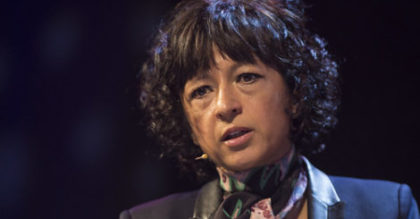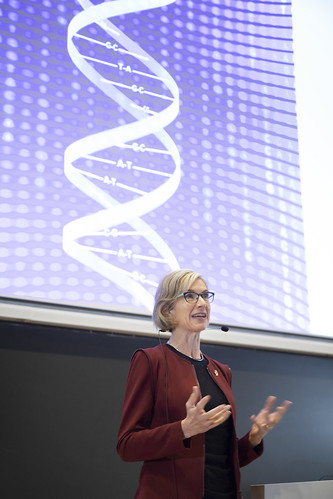
 )
)Last week we looked at the Nobel Prize for the discovery of the hepatitis C virus; there was some interest in also discussing the chemistry prize announced shortly before that post went up. That prize was shared by Emmanuelle Charpentier and Jennifer Doudna for their contributions to developing the genetic engineering pathway based on CRISPR and Cas9. The system uses small RNA molecules to target DNA with complementary sequence for modification, allowing researchers to make specific modifications to just about any part of the DNA genome of an organism. It has found applications both in basic science research and medicine; for the latter, it brings the possibility that diseases like sickle cell anemia with known genetic causes can be treated at that genetic root.
You may also recall the CRISPR/Cas9 system as central to the controversy over editing human embryos. While the technology is precise, it is not perfectly so. Especially when working with larger genomes, there is the potential for unintended additional modifications. When the technique is applied to specific cells in the body of an adult, the risks are relatively limited in scope and potentially outweighed by the benefit of treating a disease. But in embryonic cells, the risks extend over the whole body and the entire lifespan, and can even potentially be passed on to successive generations. And so, as with many powerful technologies, it needs to be applied judiciously. This is familiar territory for the Nobel prizes, which are funded partially by Alfred Nobel’s dynamite earnings (he also had another of patented invetions).
Less common for the Nobels is a pair of woman laureates in chemistry, or any of the categories. In the North American & European worlds of science and top prizes, it is often the case that men are overrepresented in general and people of color are underrepresented at least with respect to current demographics. The Nobel committee has expressed interest in addressing those imbalances, which may factor into this selection in the chemistry category. As with nearly all laureates, Charpentier and Doudna did not work in isolation and other independent research groups have made significant contributions to demonstrating the broad potential and refining the procedures of CRISPR/Cas9 technology. Someone else could have been included (the max for a category is three recipients), and the pair have shared other prizes with CRISPR/Cas9 researchers including Feng Zhang and Virginijus Šikšnys.

 )
)Also somewhat notable is the timeframe of the work. The potential of CRISPR and Cas9 to be employed for targeted gene editing was proposed by Charpentier and Doudna in 2012, and in just 8 years that potential has been realized and refined to the point that students are using it in labs all over the world. By comparison, the possibility of an unknown hepatitis virus was recognized in the 1970s and the first hepatitis C virus paper was published in 1989, more than 30 years before being recognized with a Nobel last week. And in physics, Roger Penrose won for theoretical work dating back to the 1960s–albeit alongside observational work of Reinhard Genzel and Andrea Ghez from the past decade. It is not uncommon for research to take decades until its significance is established enough to be considered prizeworthy, which makes the Nobel Prizes something of a snapshot of the past.
Thus it is probably not unrelated that the chemistry prize went to recent work and to two women. Harvey Alter, the most senior of the trio of laureates for the hepatitis C work, received his medical degree in 1960, years before either Charpentier (1968) or Doudna (1964) were born. The gender distribution and the opportunities for women in science were different 60 years ago. Thus the opportunities for women to have done science then that could now be recognized with a Nobel prize were scarcer. The story for people of color is similar; consider that Jim Crow laws were still enforced when Alter became a doctor.
None of this is meant as a criticism of specific past or present laureates. At the same time, it is also not an excuse for the Nobel committee to be passive about the demographics of future winners. What I hope to highlight is the way in which biases can persist and compound over time. Sure, eventually more women and more people of color will win Nobel prizes simply because they have had more opportunities in recent years to pursue careers in science and do prizeworthy work. And we could just wait for that to happen, but if it is important to us that the scientists we hold up as most notable represent everyone currently working in science and everyone we hope will someday contribute to science in the future, then active choices need to be made.
And to be clear, I don’t think such choices mean a change in standards. Consider that the recent pace of scientific publishing is on a scale where the number of total papers every published doubles roughly every 10 years. To put it another way, 3 out of every 4 papers has been published since 2020. And there is an upward trend in number of authors as well, particularly in physics. Now, some of that increase may have to do with more and lower quality journals or other factors unrelated to productivity, but it must also indicate some real increase in the amount of science being done, whatever the units for that might be. So even if there were only one Nobel-worthy accomplishment per field per year when the prize was created 120 years ago, how many such accomplishments are occurring now? And considering that the prize can look back decades (the only limitation being that the winners must be alive), that should be a sizable pool from which to draw if we want to have winners reflecting the current demographics of scientists.
Andy has worn many hats in his life. He knows this is a dreadfully clichéd notion, but since it is also literally true he uses it anyway. Among his current metaphorical hats: husband of one wife, father of two teenagers, reader of science fiction and science fact, enthusiast of contemporary symphonic music, and chief science officer. Previous metaphorical hats include: comp bio postdoc, molecular biology grad student, InterVarsity chapter president (that one came with a literal hat), music store clerk, house painter, and mosquito trapper. Among his more unique literal hats: British bobby, captain’s hats (of varying levels of authenticity) of several specific vessels, a deerstalker from 221B Baker St, and a railroad engineer’s cap. His monthly Science in Review is drawn from his weekly Science Corner posts — Wednesdays, 8am (Eastern) on the Emerging Scholars Network Blog. His book Faith across the Multiverse is available from Hendrickson.

Leave a Reply